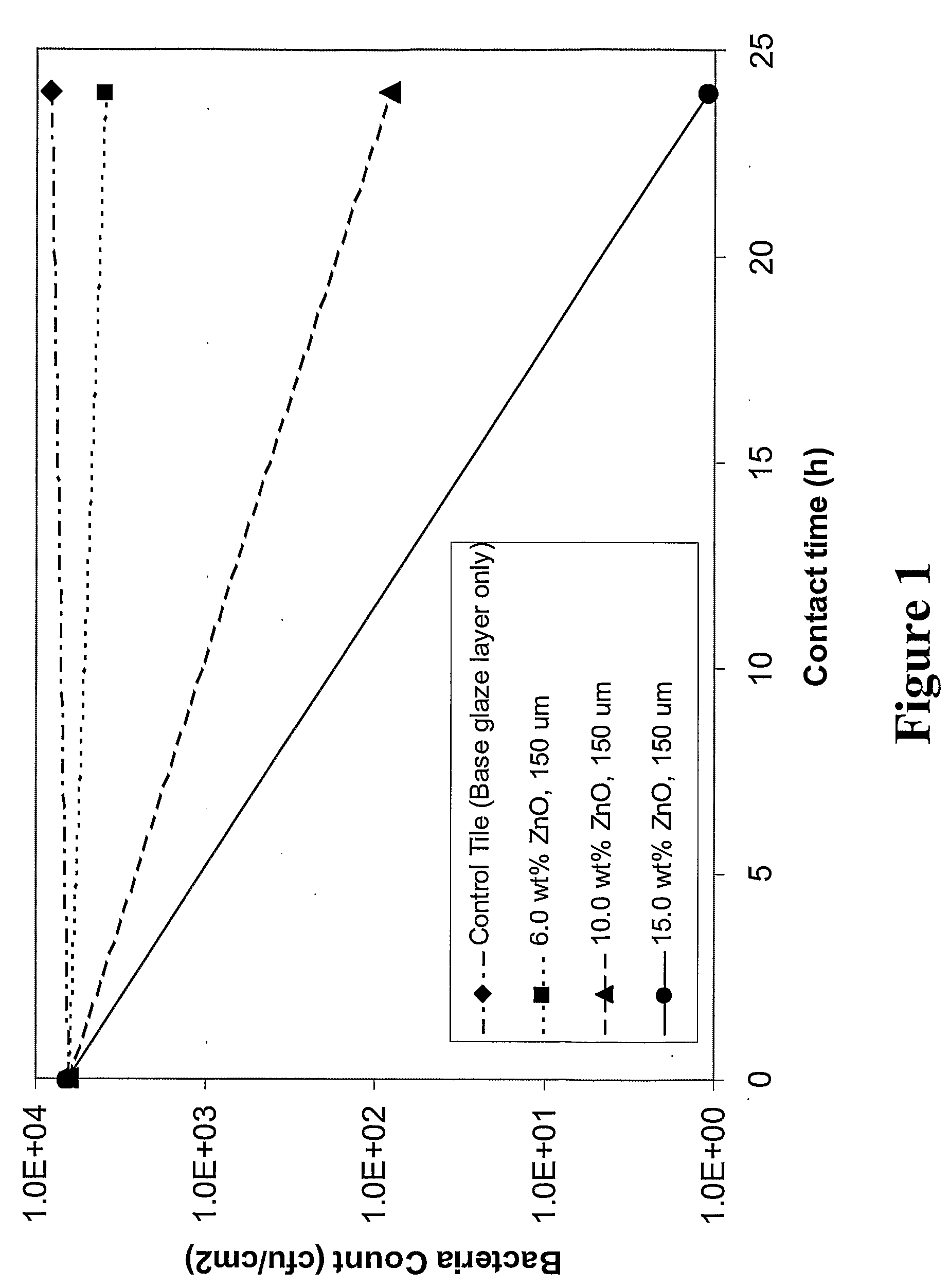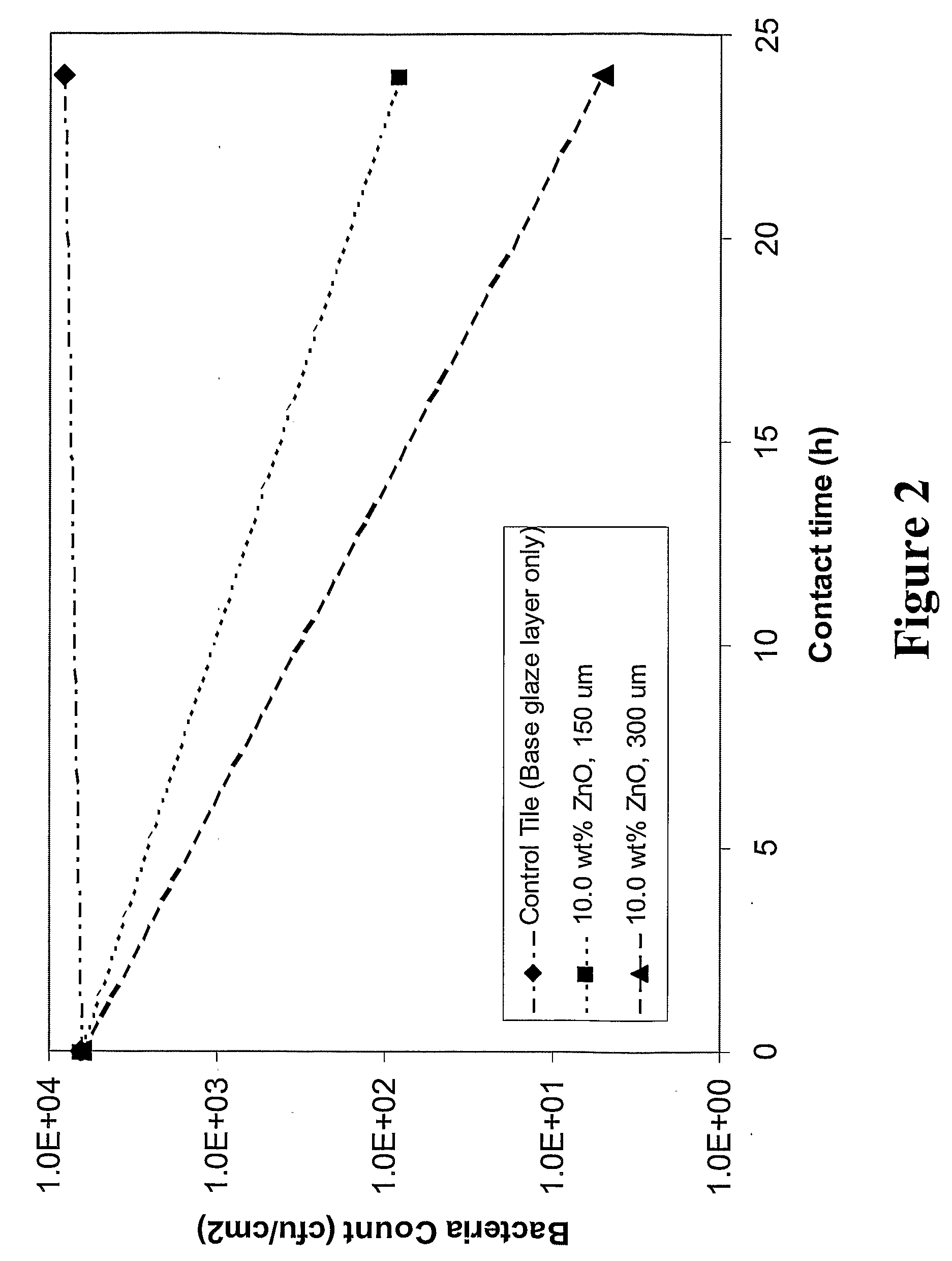Antimicrobial glaze and poreclain enamel via double layer glaze with high zinc content
a technology of zinc content and antimicrobial glaze, which is applied in the field of ceramic glaze layer, can solve the problems of unacceptably large glaze cost increase, low antimicrobial silver content, and high cost of silver compounds, and achieve good glaze quality
- Summary
- Abstract
- Description
- Claims
- Application Information
AI Technical Summary
Benefits of technology
Problems solved by technology
Method used
Image
Examples
example 1
[0023]A series of ceramic tiles were prepared with base layer compositions according to Table 1 and top layer compositions containing 6.0 wt %, 10.0 wt %, 15.0 wt %, and 25.0 wt % ZnO. The base layer was sprayed to give a post-fire thickness of approximately 450 μm. After allowing approximately 5 minutes for the base layer to dry in ambient air, the top layer was sprayed on to the base layer to a post-fire thickness of approximately 150 μm. The tiles were then fired in air at a temperature of 1215° C. for a soak time of 45 minutes. Upon cooling and removal from the furnace, the samples were subjected to antimicrobial efficacy testing in accordance with the procedures outlined in the Japanese Standard JIS Z2801. A ceramic tile with the identical base layer and no top layer was prepared at the same time and used as the control tile. The results of these tests are shown in Table 4 and FIG. 1. The results indicate that the sample with 6 wt % ZnO in the top layer has little of no efficac...
example 2
[0024]Additional sample tiles were prepared according to the procedure given in Example 1, with the exception that the post-fire thickness of the top layer was varied from 150 μm to 300 μm. These samples were then subjected to antimicrobial efficacy testing in accordance with the procedures outlined in the Japanese Standard JIS Z2801. FIG. 2 shows the difference in antimicrobial efficacy against Staph Aureus of samples with a 10 wt % ZnO top glaze layer at different thickness. The efficacy is improved when the thickness is increased from 150 μm to 300 μm.
TABLE 4Bacteria counts (in colony forming units / cm2) duringJIS Z2801 testing of samples described in Example 1.Contact time againstZnO level in top glaze layer0 hours24 hoursControl Tile (0% ZnO)6.5 × 1038.3 × 103 6.0 wt % ZnO, 150 μm6.5 × 1034.0 × 10310.0 wt % ZnO, 150 μm6.5 × 1038.3 × 10115.0 wt % ZnO, 150 μm6.5 × 1031.1 × 100
PUM
| Property | Measurement | Unit |
|---|---|---|
| thickness | aaaaa | aaaaa |
| thickness | aaaaa | aaaaa |
| thickness | aaaaa | aaaaa |
Abstract
Description
Claims
Application Information
 Login to View More
Login to View More - R&D
- Intellectual Property
- Life Sciences
- Materials
- Tech Scout
- Unparalleled Data Quality
- Higher Quality Content
- 60% Fewer Hallucinations
Browse by: Latest US Patents, China's latest patents, Technical Efficacy Thesaurus, Application Domain, Technology Topic, Popular Technical Reports.
© 2025 PatSnap. All rights reserved.Legal|Privacy policy|Modern Slavery Act Transparency Statement|Sitemap|About US| Contact US: help@patsnap.com


